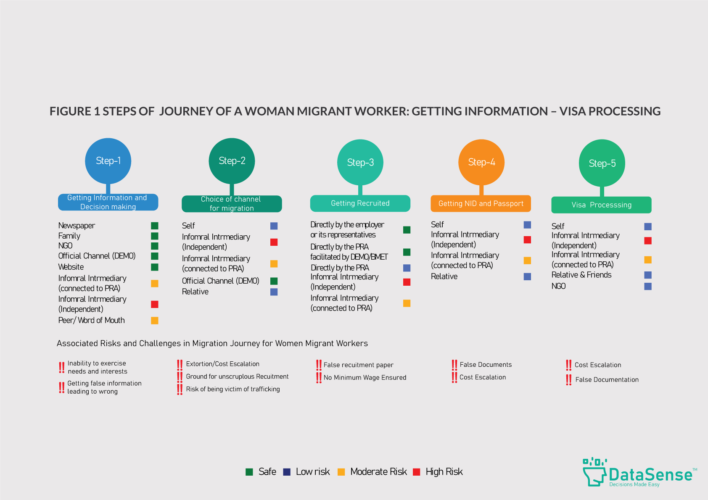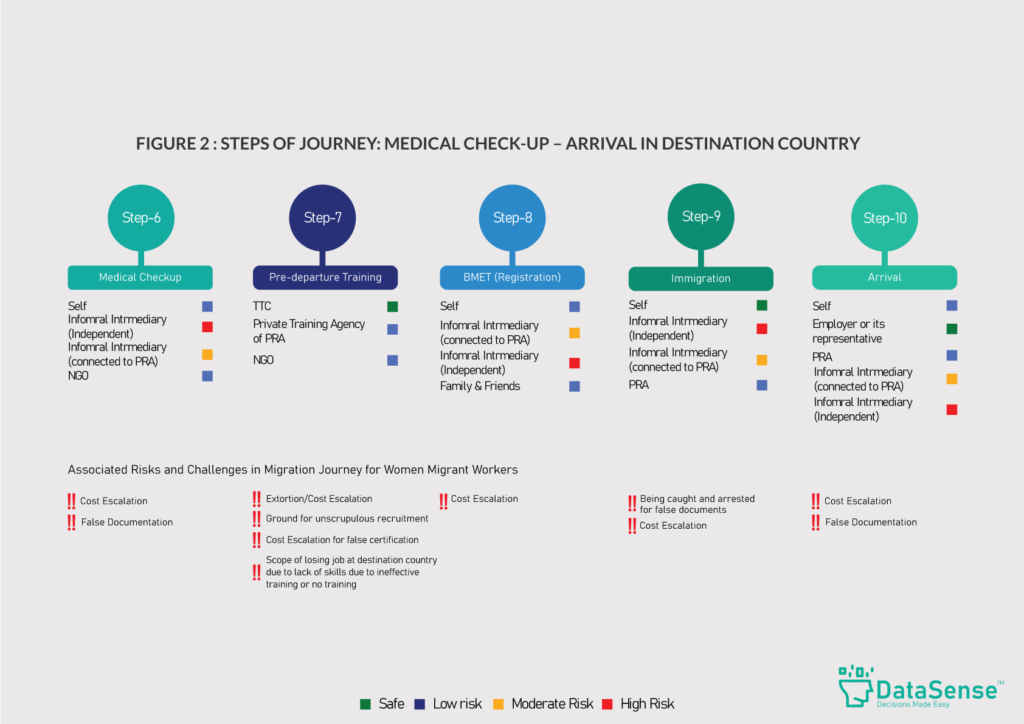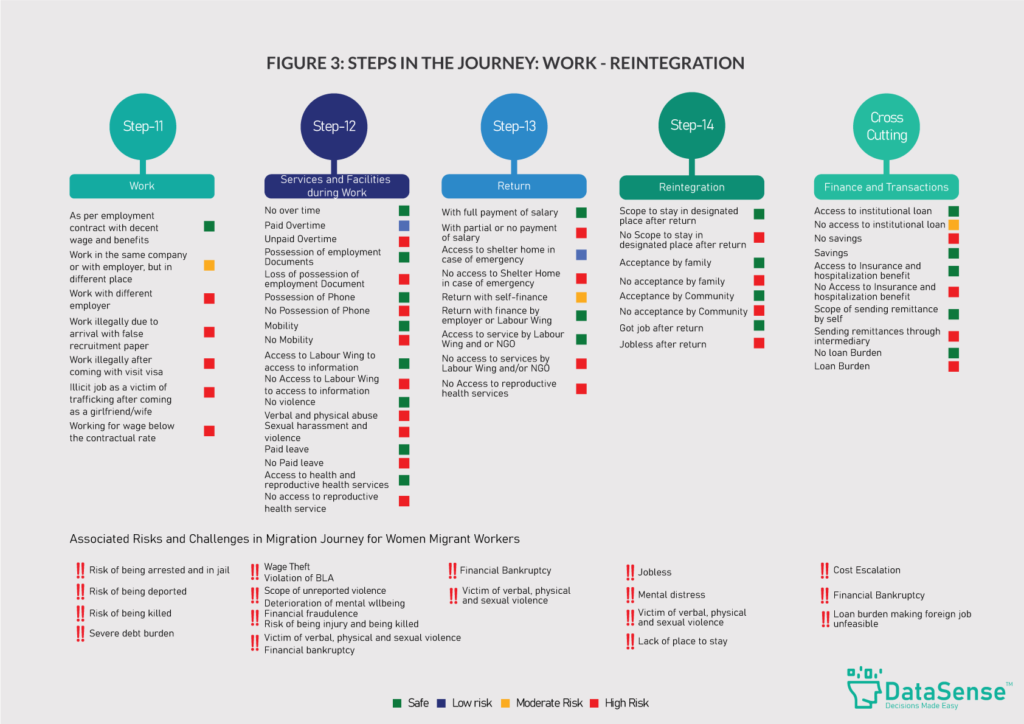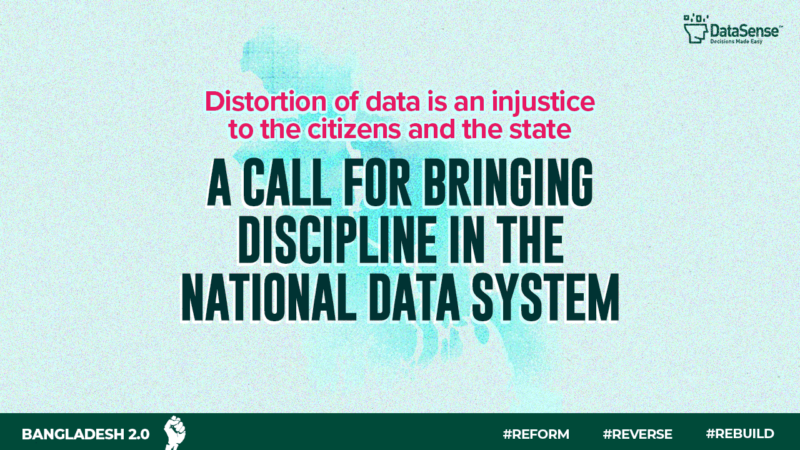Journey of a Woman Migrant Worker: Issues, Risks and Challenges

In Bangladesh, women started participating in labour migration since 1991, as of November 2022, total around 1.11 million women migrant workers have gone abroad, which is around 7.5% of total migration so far. [BMET 2022]. Major destination of women migrant workers is Saudi Arabia. Other destination countries are: United Arab Emirates, Jordan, Oman, Lebanon, Qatar, Hong Kong, Japan, South Korea, Malaysia and, Singapore. Major occupation is domestic help, the other occupations are Garment worker, Caregiver, Nurse, and Cleaner. Now, Bangladesh is the 6th largest migrant-sending country globally and the 7th largest remittance-receiving country [World Bank 2022].
Labour migration from Bangladesh takes several different paths depending on the channels availed by an aspirant woman migrant. In Bangladesh, the risks and challenges faced by women migrant workers can be categorized into different steps of the labour migration journey. There are fourteen broad steps in a labour migration journey for a woman. [ Figure 1, 2 ,3]. There are multiple scenarios in each step of the labour migration journey by a woman. Each scenario poses various degrees of risks: starting from ‘safe’ [deep green]to ‘high risks’ [ red], which are presented in Figure 1, 2,3. There are also two other risk levels namely ‘low risk’ [ blue] and moderate risk [ brown].

Step 1. Getting Information and Decision Making
Getting information and decision-making largely determines the subsequent risks and challenges a woman migrant worker may face. The access to information at various stages of decision-making plays a very important role.
All starts with a discussion within the family and then getting more specific information about specific scope becomes available through one of the many channels: newspaper, website, family members, relatives and acquaintances, other migrant workers’ families. In certain cases, decision-making happens within family or solely by the aspirant woman migrant workers themselves. In the majority of cases, informal intermediaries (which are both connected to a private recruitment agency and independent ones) play a major role, as they are known within community and familiar with the good practices or bad practices, depending on their interest. NGOs play an important role in making information available; however, their spread and consistency vary.
Step 2. Choice of Channel for Labour Migration
The combination of choices for women migrant workers in terms channels is self, family and friends, and DEMO. This is the safest channel combination. However, the choice is also made for an informal intermediary (both connected to a PRA and independent). The independent intermediary channel is the riskiest channel, however, remain lucrative as it appears as the biggest support for a woman, who is distressed for push factors within family. The associated risks, issues and challenges are: Extortion/ Cost escalation and ground for unscrupulous recruitment.
Step 3. Getting Recruited
This is the most important step in the whole labour migration journey of a woman. There are three safe or low-risk ways to be recruited: directly by the employer of its representatives, directly by the PRA facilitated by DEMO/BMET/NGO, and, directly by a PRA. The two risky channels are: informal intermediary (connected to PRA) with moderate risk and an independent informal intermediary. Due to choosing of the wrong channel, a woman migrant worker becomes subject to having false recruitment papers leading to being forcibly in unscrupulous jobs with no minimum wage guaranteed or benefits ensured. In many cases, the woman migrant worker chooses to go as a wife or girlfriend with a visit visa.
Step 4. Getting NID and Passport
It is rare when a woman migrant worker herself choose to get NID and passport. The low-risk mediums are self and Family and Friends. The moderately risky medium is an informal intermediary connected to a PRA and high-risk medium is the independent informal intermediary. There is no ‘safe’ medium here as in overwhelming majority of cases, the woman migrant workers are forced to pay to other intermediaries connected to passport office. In certain cases, they receive a false NID or passport. Associated risk, issues and challenges are receiving false documents, and cost escalation.
Step 5. Visa Processing
Generally, a combination of any two of the mediums are used with direct presence of the aspirant woman migrant worker: family and friends with low risk and informal intermediary connected to a PRA with moderate risk, associated with cost escalation. Sometimes, NGOs also provide assistance in getting visa. By choosing riskiest medium, the independent informal intermediary, there is chance of getting false visa document, which may lead to arrest, jail and deportation.

Step 6. Medical Check-up
The medical check-up is a less complicated step, where the women migrant workers need to go to a designated medical centre, approved by the employer in destination country. The women migrant workers become victims of extortion by unscrupulous independent migration intermediary or intermediary connected to medical centre in case when the medical report is not acceptable for visa processing. In some cases, leveraging the ignorance of women migrant workers extortion happens even when all medical parameters are alright. Sometimes, the informal intermediary connected to the PRAs also extorts leveraging ignorance of a woman migrant worker. Such instances lead to traveling with the false medical report, which may subsequently lead to deportation from the destination country and cost escalation. Generally, the employer pays for the medical check-up under a bilateral agreement with Saudi Arabia. However, due to lack of information about this provision, some women migrant workers end up paying for medical check-up.
Step 7. Skills and Pre-departure Training
Skills acquiring, and pre-departure training are two important components for migration clearance. Generally, BMET or DEMO designate a TTC to a woman migrant worker for a two-month long predeparture training, mostly for domestic works. For job specific skills acquiring, women migrant workers also go for training to a private training institute. These training institutes are owned by PRAs of Bangladesh Association for International recruiting Agencies (BAIRA). Some NGOs like BRAC also provide training, which is approved by BMET and or NSDA/BTEB. Despite the fact that the training is a mandatory requirement, through the collusion of informal intermediaries and the training facilities, many women migrant workers get certification without or partial training. This leads to the incidence of losing a job at the destination country due to lack of skills. It also leads to cost escalation due to unofficial charges for certification. In such cases, the training facilities receive money both from the employer and the women migrant workers. NGOs, BMET need to warn the women migrant workers that false certification may lead to deportation. They also need to make sure that women migrant workers know that there is no fee for such training.
Step 8. BMET-Related Formalities [ Migration Clearance]
Given that a woman migrant worker is confident and has adequate information and knowledge, she is able to complete the procedure at BMET without any trouble. However, lack of confidence and incomplete or wrong information lead to relying on intermediaries at BMET, which leads to cost escalation due to extortion.
Step 9. Immigration
After completion of all procedures and documentation, a woman migrant worker starts her journey out of the country being nervous, which is, except for repeated travel, for the first time. Knowing such vulnerability, an unscrupulous intermediary takes advantage and extort her. Sometimes, having false documentation provided by the intermediaries in earlier steps (NID, work permit, visa) lead to cancellation of journey and arrest. Falling prey to intermediary at the immigration point leads to extortion and harassment.
Step 10. Arrival
Sometimes, a representative of employer receives the women migrant worker at the airport. However, in certain cases, due to false documentation, a woman migrant worker may strand in the no man’s land barred from entry to the destination country. Depending on the type of false document, she may be arrested and subsequently is be ‘rescued’ from the no man’s land and taken to ‘possession’. A woman migrant worker may end up working for the traffickers in unscrupulous job in the destination country and any other country. Such capture may also threaten their lives.

Step 11. Work
If a woman migrant worker is lucky, she is well received by an employer and facilitated for settling down with accommodation, registration, and proper job orientation. She may start working for the job she signed for as per contract with decent wage and benefits. However, there are other scenarios, where a woman migrant worker may be with lesser luck or no luck. Sometimes, the employer may change the location of work, which is different than mentioned in the contract, with partial fulfilment of contractual obligations. This may fall into the category of moderate risk. It may also happen that the employer as per contract does not exist or did not send the work permit, the intermediary hands her over to a different employer with or without contract. This is a high-risk situation, which may result on low wage, unsafe working conditions, unpaid overtime and so on. It may also happen that the woman migrant is forced to work illegally as her documents are not genuine with a risk being caught, arrested and deported. A woman migrant worker may be forced to do job which is illicit in nature. The low wage may lead to severe debt burden and financial bankruptcy.
Step 12. Services and Facilities during work
Starting with standard working hours, it allows women migrant workers live a life where she can experience a good family and social life. It also allows her to replenish her energy for work. However, overtime is a common phenomenon for women migrant workers. Paid overtime with hours within limit of law at least compensate her sacrifice, it poses low risk of being exploited. There are instances when the women migrant workers are forced to work extra hours without any pay.
It is important that a woman migrant worker have the following facilities and benefits at work:
- Possession of employment documents.
- Possession of phone for keeping connection with family and her safety network.
- Mobility outside workspace for building and maintaining her own social network.
- Access to Bangladesh Mission and Labour Wing for accessing services and emergency.
- Paid sick leave.
- Paid annual leave.
- Health Insurance and access to healthcare.
- Access to reproductive health services.
- Maternity insurance.
- Access to legal aid and justice.
- Access to mental wellbeing support and service.
Step 13. Return
Women migrant workers may return home prematurely or after completion of her contract. It is important that they receive full payment of salary and other payables before leaving the job. Not all departure of the women migrant workers is happy. They often return being the victim of violence. They often have to pay for their return causing financial bankruptcy. Proper design and enforcement of provisions under the law may lead to addressing challenges during return.
Step 14. Reintegration
Most of the women migrant workers, irrespective of the circumstances of return, are subject to stigmatization. Many women are not well accepted by family and relatives. The community also excludes them in one or another way. This is a traumatic experience for them. The burden multiplies for those, who return empty-handed and are the victim of violence. Lack of access to productive opportunities aggravates the situation for them. They require a place to stay with dignity when the family refuses to accept them. Cultural norms and beliefs lead to such stigmatization. A strong reintegration programme for women migrant workers is essential for addressing these inhuman conditions.
Overall, women migrant workers face multiple challenges and risks at different stages of their journey. These include gender-based discrimination, exploitation, lack of access to information and services, and limited legal protection. It is essential to address these challenges through a gender-responsive approach that prioritizes the protection and empowerment of women migrant workers.
![]()



